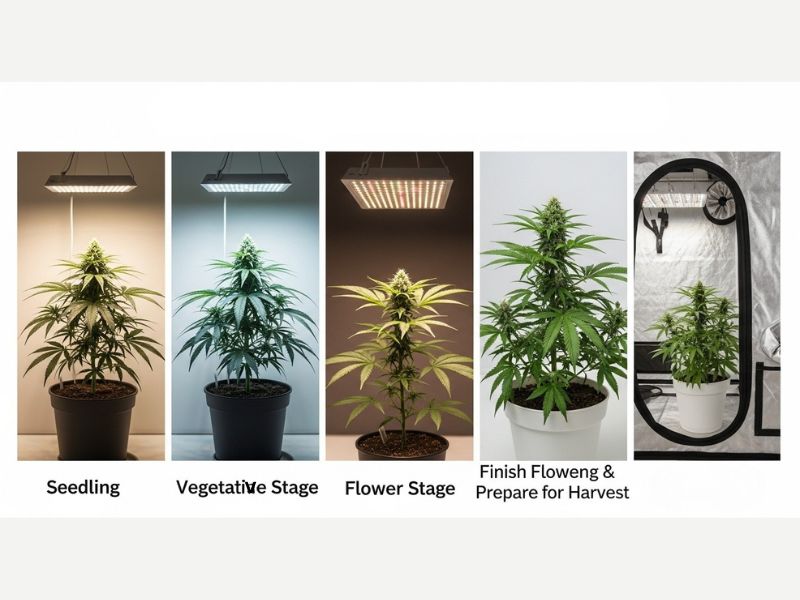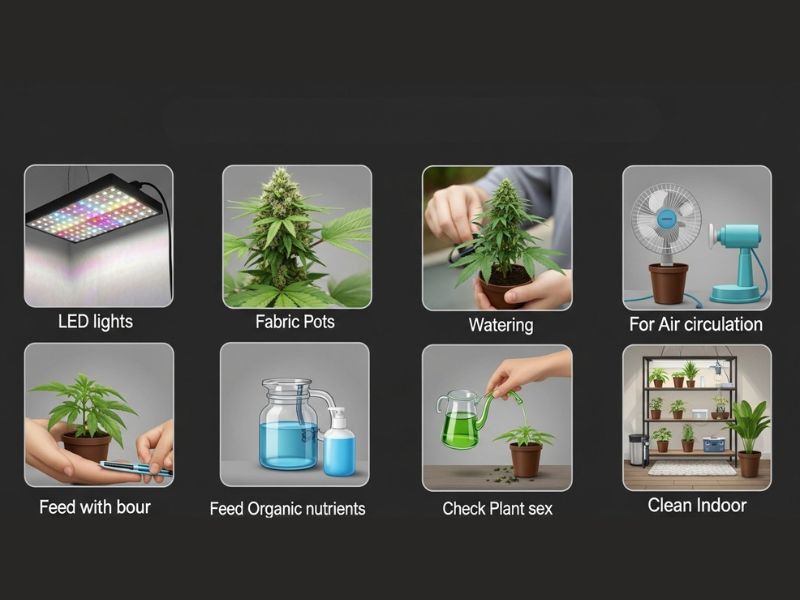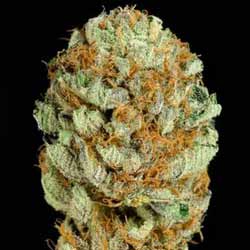Growing Marijuana Indoors: 5 Helpful Steps for Beginners
Growing marijuana indoors offers new and experienced growers more control over their environment, allowing for healthier cannabis plants and better yields. This beginner-friendly guide covers the essential steps to successfully grow cannabis indoors from seed to harvest.
Table of Contents
Can You Grow Cannabis Plants Indoors?
You can grow cannabis plants indoors with the right setup and planning. Indoor grows allow you to manage every aspect of the environment, including temperature, humidity, light schedule, and airflow, which can lead to a more successful growth.
Whether you’re working with a small grow tent or dedicating a full grow room, growing cannabis indoors gives you more control over the plant’s development from the seedling stage to the flowering stage.
Indoor Vs Outdoor Marijuana Growing
When deciding between growing marijuana indoors or outdoors, it’s essential to understand the benefits and limitations of each method. Your choice will depend on factors like climate, available space, budget, and desired control over the growing process.
Here’s a comparison table to help highlight the key differences:
|
Feature |
Indoor Growing |
Outdoor Growing |
|
Control |
More control over light, temp, humidity |
Limited by natural environment |
|
Cost |
Higher setup and energy costs |
Lower cost using natural resources |
|
Grow Season |
Year-round growing possible |
Dependent on seasons (early spring–fall) |
|
Privacy |
High privacy indoors |
Less privacy unless on private property |
|
Light Source |
Grow lights (LED, fluorescent) |
Sunlight |
|
Plant Health |
Fewer pests and diseases |
Greater exposure to pests/weather |
|
Yields |
Lower per plant but more frequent |
Higher per plant but seasonal |
|
Energy Use |
High energy demand (lights, fans) |
Low energy use |
|
Setup |
Requires grow tent or grow room |
Requires outdoor space and good climate |
|
Legal Factors |
Easier to comply with local laws |
May face restrictions on visibility or odor |
Each method has its pros and cons, but for indoor growers seeking more control and consistency, growing marijuana indoors remains a popular and reliable option.
How to Grow Marijuana Indoors

Growing marijuana indoors requires a thoughtful setup and a week-by-week approach to nurturing your plants through each stage. From choosing equipment to monitoring light cycles, this guide walks you through the steps to grow cannabis indoors successfully.
1. Gather the Necessary Materials
Before starting your grow, having the right tools and setup is essential. Here’s what you’ll need:
- Grow tent or grow space with reflective interior
- LED grow light or full-spectrum fluorescent lights
- Feminized seeds or autoflowering strains from a reputable seed source
- Fabric pots (3–5 gallons) for better root aeration
- Soil or another growing medium (e.g., coco coir, hydroponics)
- Ventilation system (inline fan, carbon filter, ducting) for fresh air and odor control
- Thermometer and hygrometer to monitor temperature and humidity
- Timer for automated light schedule
- pH tester for water and soil monitoring
- Nutrients like kelp meal, alfalfa meal, bone meal, crab meal, or Fox Farms products
- Water source and containers for mixing nutrients
- Training tools like soft plant ties or clips for low stress training
With these materials, you’re ready to move through the growing process week by week.
2. Week 1–2: Seedling Stage
This early stage is all about helping your cannabis seeds sprout and develop roots.
- Germinate your cannabis seeds using moist paper towels or by planting directly into the growing medium.
- Keep the environment warm (70–80°F) and humid (65–70%).
- Use a gentle blue light spectrum for seedlings — avoid intense light to prevent light burn.
- Provide 18–24 hours of light daily.
- Avoid overwatering, and watch for signs of root rot.
Healthy seedlings will develop their first set of true leaves during this phase.
3. Week 3–6: Vegetative Stage
During this phase, the plants grow vigorously and develop their structure.
- Increase light intensity while maintaining 18 hours of light and 6 hours of dark.
- Feed with nitrogen-rich nutrients (e.g., alfalfa meal, kelp meal) following a set feeding schedule.
- Begin low stress training to shape the canopy and encourage more buds.
- Keep temperatures between 70–85°F with humidity around 50–70%.
- Transplant to larger fabric pots if necessary.
- Ensure plenty of fresh air and carbon dioxide circulation to promote strong growth.
This stage allows indoor growers to shape their plants before flowering.
4. Week 7–10: Flowering Stage
Now the plants shift energy toward producing buds — female cannabis plants will show white pistils.
- Change the light cycle to 12 hours of light and 12 hours of darkness.
- Switch to bloom nutrients with more phosphorus and potassium.
- Watch humidity — lower it to 40–50% to avoid mold.
- Trim lower branches and leaves to focus energy on top colas.
- Monitor for light burn from intense grow lights.
- Support heavy buds with stakes or netting.
A successful grow during this stage ensures the development of resinous marijuana plants.
5. Week 11–12: Finish Flowering & Prepare for Harvest
This final stretch helps the plants reach peak potency and flavor.
- Reduce feeding and begin flushing with pure water about 1–2 weeks before harvest.
- Observe trichomes using a magnifier — milky or amber color indicates maturity.
- Maintain low humidity and moderate temperatures.
- Limit hot air circulation and keep stress low.
At this point, indoor cannabis is nearly ready for harvest — your effort from seed to harvest is about to pay off.
Tips to Properly Handle Indoor Cannabis Plants

Handling indoor cannabis plants with care throughout their growth cycle is crucial to ensuring a healthy and productive grow. These tips will help you avoid common mistakes and support optimal development.
- Monitor your light schedule consistently: Sudden changes in the light cycle can stress cannabis plants and affect flowering. Use a timer to maintain a steady routine.
- Avoid overwatering: Too much water can lead to root rot. Always check soil moisture and ensure proper drainage in your fabric pots.
- Use energy-efficient grow lights: LED grow lights are preferred for indoor grows because they emit less heat and lower electricity costs while providing all the light cannabis needs.
- Trim and train regularly: Use low stress training (LST) techniques to expose more bud sites to light, increasing yield without harming your plants.
- Feed with natural amendments: Nutrients like crab meal, kelp meal, bone meal, and alfalfa meal can improve plant health while reducing the risk of chemical burn.
- Keep the grow space clean: A clean grow room reduces pests and disease. Wipe surfaces, remove dead leaves, and avoid standing water.
- Ensure proper air circulation: Use fans to prevent hot air pockets and promote fresh air exchange, helping strengthen stems and discourage mold.
- Check plant sex early: Remove male plants unless you’re breeding. Female plants are the ones that produce buds rich in cannabinoids.
- Know your local laws: Always understand the legal limits and requirements for growing weed indoors in your area.
- Start with feminized seeds from a reputable seed source: This helps ensure you’re growing female cannabis plants that will produce buds without accidental pollination.
Using these tips, indoor growers can improve plant health, reduce stress, and ensure a more successful grow from start to finish.
Final Thoughts
Growing marijuana indoors gives you more control, flexibility, and the potential for a successful grow year-round. By understanding each stage, using the right tools, and following proven techniques, you can enjoy the process from seed to harvest.Ready to grow with confidence? Start by gathering your setup, selecting quality seeds, and following proven indoor techniques to cultivate healthy, high-yield cannabis plants.
Frequently Asked Questions
What size grow tent should I use for indoor cannabis?
For beginners, a 2×2 or 3×3 grow tent is ideal for growing 1–2 marijuana plants. If you plan to grow more plants, a 4×4 or larger tent offers more space and better airflow management.
How often should I water cannabis plants indoors?
Water every 2–4 days depending on plant size, pot size, and growing medium. Always check soil moisture 1–2 inches deep before watering.
Can I grow cannabis in an apartment?
Yes, growing indoors in a small space like an apartment is possible using compact grow tents, odor control systems, and LED lights. Just make sure to comply with local laws and regulations.
What’s the best temperature and humidity for indoor cannabis?
During the vegetative stage, aim for 70–85°F with 50–70% humidity. In the flowering stage, maintain 65–80°F with 40–50% humidity for optimal bud development.
Do I need carbon dioxide for growing cannabis indoors?
Supplementing with carbon dioxide (CO₂) can increase yield, but it’s not essential for small-scale or beginner grows. Proper ventilation and fresh air are usually sufficient.
How long does it take to grow cannabis indoors?
From seed to harvest, growing indoor cannabis typically takes 3–5 months depending on the strain and growing conditions.
Can I clone a cannabis plant indoors?
Yes, you can take cuttings from a healthy mother plant to create genetically identical clones. This method is cost-effective and preserves desirable traits.
Related Posts
Cloning Cannabis: 5 Great Benefits and Step-By-Step Guide
6 Ways to Effectively Utilize Male Marijuana Plants
Cannabis Trimming: 5 Benefits and How to Do It Properly
CATEGORIES
Best Selling Seeds











